Paying attention to how you're capturing images, who is in your media, and how they are framed in the photo will help ensure that every visual element we create aligns with UVM's values, telling our story with authenticity, inclusivity, and impact - and elevating your project in the process.
Photo and Video Resources
The "UVM Style"
UVM photography and videography should feel natural, energetic and “in the moment,” to highlight UVM’s strengths in providing hands-on and experiential learning opportunities. As much as possible, the camera should be in-the-action and subjects should be shown in-motion, interacting with each other and their environment using natural light. Imagery should highlight our campus’ high level of academic facilities, diversity of classrooms, exciting research, and beautiful Vermont environment when possible.
Spotlights

Feature or Spotlight Photos are those typically shot to be paired with a story or narrative showcasing the talents of a member (or small group of members) of our community. These photos should feel un-posed, relaxed, and candid—showing subjects within their natural environment, area of study, job, or interest. When paired with a written piece, feature photos should enhance the unique story being told and will add depth to the overall creative work and storytelling being communicated by showcasing the action being represented. When capturing subjects, engage them in discussion to avoid posed shots and embrace their natural gestures.
Portraits

Portraits are typically shot for biography-style placements in publications and on the web. For this type of photo, simple head and shoulder horizontal style portrait, with the subject looking directly at the camera is most appropriate. Ensure there is adequate clearance (space) around your subject to ensure good web placement. Avoid plain, solid-color backgrounds and dim lighting, and embrace depth of field behind your subjects.